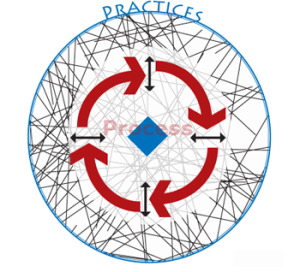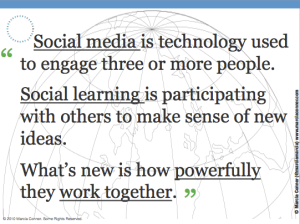 We know that most learning in the workplace is informal. Most observers put it at around 80%. Recently, John Hagel and John Seeley Brown contended that “as much as two-thirds of headcount time in major enterprise functions like marketing, manufacturing and supply chain management is spent on exception handling.” Of course, that fact is a result of the successes of process automation over the past few decades. Yet, still, The Barely Repeatable Process (BRP) persists as an organizational challenge for business.
We know that most learning in the workplace is informal. Most observers put it at around 80%. Recently, John Hagel and John Seeley Brown contended that “as much as two-thirds of headcount time in major enterprise functions like marketing, manufacturing and supply chain management is spent on exception handling.” Of course, that fact is a result of the successes of process automation over the past few decades. Yet, still, The Barely Repeatable Process (BRP) persists as an organizational challenge for business.
Earlier discussions here focused on the importance of exceptions, to business process and formal learning. I examined the implications of the Kirkpatrick Evaluation model to the use of social media in learning experience design, while addressing the challenges facing learning leaders. Leading the Business-Centered Learning Experience noted that evaluating formal learning is as much about organizational learning and change management as it is about individual learning, largely because much of the learning, and performance, that matters today occurs at the group level. Marc Rosenberg recently echoed the point in an article in Learning Solutions Magazine, The Special Sauce of Social Learning. Marc noted that social learning is largely a change management challenge for organizations.
The most basic point to remember is that exceptions to formal business processes require efforts to design a scalable learning architecture that supports content co-creation needed to adapt to emergent challenges and manage the flow of that adaptation through an enterprise’s ecosystem. Whether judging an adaptation successful requires it to result in new formal learning content, i.e. content co-creation, or a new business process, i.e. organizational innovation, or both, remains an open question.
Echoing John Hagel, John Seeley Brown, and Lang Davison’s focus on The Big Shift, Tim Young recently noted the following about social networking and exception handling,
When an exception happens, we have to step away from our PowerPoint, stop typing an email, or exit a meeting in order to take care of it. Routine work stops. And, our modern reliance on technology to find, aggregate, and alert us to these exceptions has made the task of managing them more burdensome than ever before. Systems that manage exceptions provide the enterprise with vast amounts of data points that have become overwhelming for employees to handle. The applications that we rely on for managing exceptions still rely on process owners to make decisions and respond to the issues. The result is a workforce that isn’t dealing with exceptions well at all. (my emphasis)
The importance of social networking to increasing the effective handling of exceptions is a major focus for those interested in social learning.
Exception Handling as a Learning Opportunity
I’ll use the definition of learning offered in The New Social Learning, by Tony Bingham and Marcia Conner. Learning is “the transformative process of taking in information that, when internalized and mixed with what we have experienced, changes what we know and builds on what we can do.”
Exceptions occur under a range of circumstances. For example, customers needing non-standard financing terms, managers needing to find transaction codes for unusual logistics requirements, or a software developer needing to resolve a coding problem involving multiple dependencies, and any of a host of other challenges faced in business that ERP, HR, CRM, and other enterprise systems don’t take into account. At the same time, exceptions create the opportunity for painful touch points of experience for stakeholders in the business ecosystem, especially customers.
The objectives for most formal learning content are derived from the goals of formal business processes, whether the learning content is push or pull in design. On the other hand, the practical innovations, workarounds, necessary to adapt to business exceptions are a significant part of the informal learning in any enterprise. Those same workarounds reveal how stakeholders improvise practices, usually manually through BRPs, to manage exceptions.
Business processes supporting Enterprises are, by definition, as rigid as possible and defined around automated controls over workflow, all the while tracked as transactions. We know what the demand and price is on a product or service, we know how long it takes to make and distribute, we know whether it is bought, we know who bought it, and typically a lot more about them.
Handling exceptions to current processes falls within the domain of informal learning but, more specifically, social learning. Marcia Conner (@marciamarcia) puts it well in a recent Fast Company article:
Training often gives people solutions to problems already solved. Collaboration addresses challenges no one has overcome before. Social learning makes that immediate, enabling people to easily interact with those with whom they share a workplace, a passion, a curiosity, a skill, or a need.
Designing and developing organizational capabilities for smoothing out the way exceptions are handled is a key challenge for those interested in social learning. Consider the following graphic offered by Marcia in defining social learning.
In other words, social media and social learning work most powerfully together when they support a design approach to enabling business strategy. The point is important because the value that social relationships bring to business is bounded by how well employees handle exceptional requests from key stakeholders in the ecosystem, whether they are customers, business partners, or other employees.
Posted by Larry R. Irons
Share this post…














Spot on!
Re-usability (and correspondingly perishability) is a core outcome of Social Learning. As a mentor rather than being asked 10x for a single “knowledge object” or “item of expertise,” I can be asked once and the organization can refer to that knowledge nugget in an ongoing way. My expertise is shared, de-siloed if you will, and I don’t need to be “interrupted” to be asked the same question 10X. Informal Learning done right is like an ad-hoc support desk for sharing knowhow across the organization.
Do let me know how I can assist you in your thinking and problem solving…
David Koehn
Director of Product Strategy, Saba
Hi David,
Thanks for stopping by and offering your thoughts on this post. I had considered taking it into a more lengthy discussion of the Great LMS Debate and the differing viewpoints on whether an LMS can provide the collaborative resources necessary for supporting observable work. Perhaps that is a subject another post will use to extend this line of thinking.
Larry
Great let me know if I can help!
I can fully subscribe to a design for enabling business strategy. However, this should not be a design of rigid processes with some add-ons for collaboration and interaction but a design that allows for empowerment of users taking control of their processes in order to fulfill strategic business goals as broadly defined by management and governed by business policies.
Michael,
I totally agree. Your point aptly describes some of the key limitations in Sharepoint when enterprises try to use it as a collaboration platform. It continues to fall short in the social networking and collaboration requirements for supporting informal and social learning. I noted a similar point a couple of years ago about this issues and it continues to remain relevant.
Hi Larry,
just discovered that older post of yours on Sharepoint and found it very much to the point. Sharepoint is probably the most prominent example of these shortcomings but by far not the only one.
Good post & I’m glad to see the reference to BRP, which is something that no enterprise software vendors, from ERP to LMS, really understand or have in any way implemented. Social learning and working smarter are much more about supporting people & developing processes, not some quick technology fix. It’s great to watch what Sig is doing with BRP and Thingamy, which is a beacon of light in this over-hyped enterprise software market.
Hi Harold,
Thanks stopping by and offering feedback, especially given the fact that your writing has informed my thinking for a while now, especially this post. Totally agree on the importance of BRP to ERP and LMS.
Larry
[…] https://skilfulminds.com/2010/12/09/social-learning-and-exception-handling/ […]
Hi Larry,
Further to our exchange on Twitter, I suggest you take a look at Adaptive Case Management, which aims to deal with unpredictable, ad-hoc processes – whilst at the same time maintaining visibility, traceability and accountability.
In ACM you have a goal, but you don’t know which path you’re going to take to get to it, as it depends on the various inputs and outcomes of each of the steps, in particular that of the Knowledge Worker.
ACM as an acronym is misleading (it’s not only about cases) but can be used as a framework for any BRP, including Social Learning – I have written a little piece on it here http://marktamis.com/2010/10/27/service-agility-thru-adaptive-case-management/
Cheers!
Mark
Thanks for the clarification Mark. I’ll read the link carefully.
Mark, Larry,
the attribute “adaptive” in conjunction with “case management” has been agreed upon at a WfMC meeting about a year ago. You can find out more about it and additional information on Keith Swenson’s blog: http://kswenson.wordpress.com/
You may also read about the Papyrus approach to ACM here (with the usual grain of salt, of course:-), but with enough proof that we are not just jumping the latest bandwagon): http://www.adaptive-case-management.com/ and here: http://isismjpucher.wordpress.com/ and hopefully in Mark’s follow-up which was announced in the mentioned post.
Thank you Michael for putting pressure on me to write the follow-up 😉
I think “Case Management” as such doesn’t do justice to the potential of ACM to change the way we work and learn. It could for example help in the Sales cycle, how we do Project Management by capturing emrgent practices and so on – but that is just my opinion…
[…] (Barely Repeatable Processes) ‘Social Learning & Exception Handling‘ @lirons via @jonhusband We know that most learning in the workplace is informal. Most […]
Hello,
Great article, I found this article very interesting but I think about this subject from a slightly different perspective. I work for a small ISV and this is something that we have encountered and it has led us to develop CodeSmith Insight (http://www.codesmithtools.com/product/insight). We noticed that there are exceptions that popup in applications all the time; be it in production or during a demo and it forces the end user or group of individuals to focus on a new issue that could be a very frustrating experience. We saw this as a pain point and let the user log their comments and thoughts and continue on the task. The whole time they know that we will get back to them and that we have most if not all of the information needed to fix the issue that occurred. If you don’t have this kind of infrastructure than your presenters will get off hand to try and fix the issue, your customers complaints could get lost and not taken care of. This causes loss of time for all recipients as well as a potential headache coming from bad social media PR.
This is how Insight will help you manage these efficiently as well as respond across different communication points like email and social media. We allow an individual or corporation the ability to catch these exceptions in great detail, allowing the presenter to keep going and let the person responsible follow up and take action. I think it is only a matter of time before applications in general use a system like Insight to keep track of all these great and negative experiences in order to make sure there are more GREAT experiences for users.
Thanks
-Blake Niemyjski
Greaat read thankyou